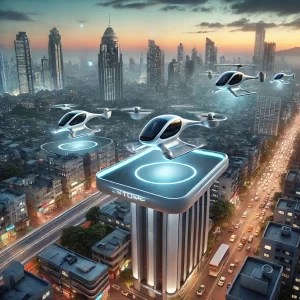What Are Electric Air Taxis?
Electric air taxis are small, electrically powered vertical take-off and landing (eVTOL) aircraft designed for short urban and regional flights. They are envisioned to provide an alternative to traditional ground transportation, significantly reducing travel times while being environmentally friendly.
These aircraft typically rely on electric motors powered by batteries, eliminating the need for fossil fuels. With advanced designs incorporating features like autonomous flight systems and quiet rotor technology, electric air taxis are engineered to be safer, quieter, and more efficient than conventional helicopters.
Why India Needs Electric Air Taxis
India’s transportation network is under immense pressure. Cities like Mumbai, Delhi, and Bengaluru are notorious for their traffic snarls, with commuters spending hours on the road daily. Here’s why electric air taxis could be a game-changer for the country:
- Reducing Congestion: Air taxis can bypass traffic, cutting travel times drastically. A journey that takes over an hour on congested roads could be reduced to mere minutes.
- Eco-Friendly Transportation: With zero emissions, electric air taxis align with India’s push for greener, cleaner cities.
- Time-Saving for Business Travelers: Air taxis could become the preferred mode for business executives needing to commute between city centers, airports, or industrial hubs quickly.
- Connectivity to Remote Areas: They hold the potential to improve connectivity to underserved or hard-to-reach regions, especially where road infrastructure is poor.
- Emergency Response: Electric air taxis could revolutionize emergency medical services by providing rapid airlifts, saving lives in critical situations.
Key Players and Developments in the Sector
Several international companies are leading the electric air taxi revolution, including Joby Aviation, Volocopter, Lilium, and Archer Aviation. Indian startups and companies are also eyeing this market, with a focus on localizing technology to suit the country’s unique landscape.
- Joby Aviation and Lilium are exploring collaborations to enter the Indian market.
- ePlane Company, an IIT Madras-based startup, is developing hybrid electric air taxis aimed at short urban commutes.
- Hindustan Aeronautics Limited (HAL) and Mahindra Aerospace are reportedly evaluating the feasibility of producing air taxi technology domestically.
Infrastructure Requirements
For electric air taxis to become a reality in India, substantial infrastructure development is essential. This includes:
- Vertiports: Specially designed landing and take-off hubs integrated within urban areas, airports, and strategic locations.
- Charging Stations: Rapid charging infrastructure to ensure quick turnaround times for air taxis.
- Air Traffic Management: A new airspace control system to manage low-altitude flights and prevent congestion in the skies.
- Maintenance Facilities: Service hubs to ensure aircraft safety and operational readiness.
Regulatory and Safety Challenges
The rollout of electric air taxis in India requires more than just infrastructure. Regulatory frameworks, safety standards, and public acceptance play a significant role. Some key challenges include:
- Certification and Compliance: Aircraft need to meet stringent safety and performance standards set by the Directorate General of Civil Aviation (DGCA).
- Pilot Training and Autonomous Operations: Transitioning to autonomous flights may take time. Until then, certified pilots will be essential.
- Noise Control: Although quieter than helicopters, air taxis must meet urban noise pollution guidelines.
- Public Trust: Building public confidence in a new form of transport will require extensive testing and demonstration of safety records.
Economic and Social Implications
Electric air taxis could spur economic growth by creating new industries around manufacturing, maintenance, and operations. The rise of urban air mobility (UAM) could lead to:
- Job Creation: Engineers, pilots, maintenance crews, and air traffic controllers will be in demand.
- Boost to Tourism: Scenic aerial routes over iconic destinations could offer tourists a unique, time-saving experience.
- Affordable Air Travel: While initially a premium service, scaling operations and advancements in battery technology could make air taxis more accessible over time.
The Road Ahead
India’s journey toward electric air taxis will likely unfold in phases:
- Pilot Programs (2025-2027): Initial trials in select cities to test safety, infrastructure, and public reception.
- Commercial Launch (2028-2030): Full-scale operations in major metros and high-traffic corridors.
- Expansion to Tier 2 and Tier 3 Cities (2030 onwards): Wider adoption in smaller cities and remote regions.
Conclusion
Electric air taxis are no longer a far-fetched concept — they’re on the horizon. While challenges remain, India’s push for innovation, coupled with advancements in electric aviation technology, makes this an exciting and feasible development. With the right infrastructure, regulations, and market forces, air taxis could redefine urban mobility, reduce congestion, and pave the way for a cleaner, faster, and more connected future.
As the world watches this technological marvel unfold, India has the opportunity to position itself as a leader in sustainable urban air mobility. The sky, quite literally, is the limit.


